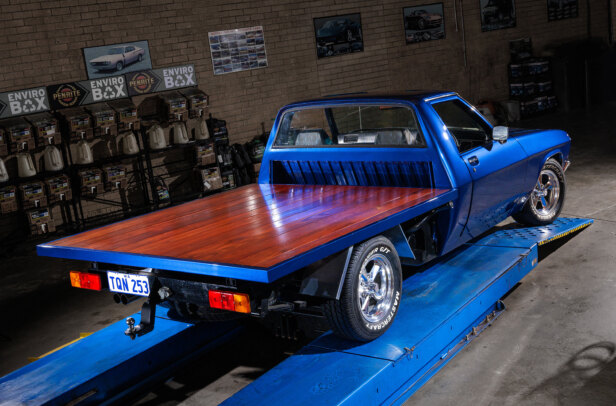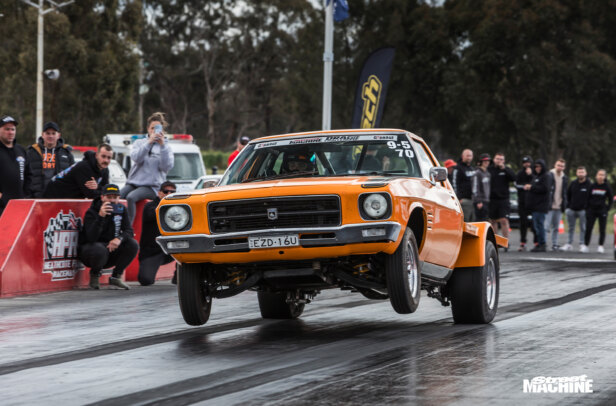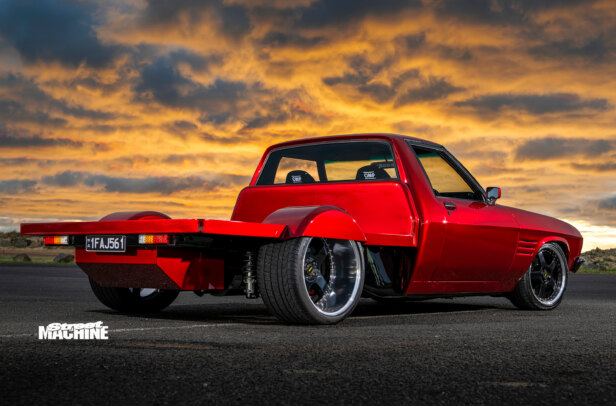Twenty odd years ago, The General rolled the first One Tonner off the production line. Ever since, the humble One Tonner has hauled just about everything and anything you can think of.
First published in the December 1991 issue of Street Machine
Now, “hauling” means different things to different blokes. Con and Vic Elfes don’t really think like the vast majority of One Tonner owners. They don’t give a proverbial how comfy the cattle dogs are, or how many bales of hay or drums of sheep dip you can fit in the back. Serious hauling is what’s on their minds.
Con and Vic, who run C&V Performance in Sydney, aren’t what you’d call limp-wristed. Their street One Tonner is this car’s twin brother, and even it runs 10-second quarters! Most blokes would be happy with that, but not this pair. So, about a year ago, they decided the time was right to step up to a full on, purpose built racer.
This One Tonner has been re-engineered from the ground up. About the only thing bearing any similarity to the stock Holden product is the outside shape – and even that ain’t exactly stock.
And this is where Mark Sgaravizzi, Mr Racefab, fits into the picture. Mark’s no stranger to Street Machine. He’s had a swag of cars featured over the years and is largely responsible for building this masterpiece. He sure got something right, ‘cos the damn thing’s about 600kg lighter than its streetable brother. The Racelab custom space frame chassis powder coated in Blaze Blue by Australian Powder Coating Industries has a lot to do with that. It’s made the car stiffer (and safer) than stock, and lighter into the bargain.
Other big weight-savers are the Top Touch fibreglass panels, and the hand-made Racefab polycarbonate windows. The rear tray looks solid enough, but mega weight was saved here, too. It’s just for show, and is topped with one millimetre-thick aluminium sheet.
The horsepower factory is a Bow Tie 454 Chev with imported alloy Chev heads. They arrived ex-USA, ready to be assembled and run. The block was machined by Bakers, and now runs an LS7 crank inside Michigan bearings. Venolla rods keep the 13:1 Venolla pistons pumping. Sealed Power rings maximise cylinder pressures and keep the smog out of the sump. A Mellings oil pump keeps the system slippery at full song. Even engines which only do their thing for about nine seconds at a time can melt down, so a small Lakewood alloy competition radiator with plastic tanks was added. For safety and looks, braided line has been used throughout.
A Crane Cam stick with 0.765 inch lift and 320 degree duration belts the hell out of a set of Competition Cams roller lifters and Crower pushrods. Manley valves are activated by Crower rocker arms and close under the influence of Isky valve springs.
Inlet starts out with a custom Hornet bonnet scoop feeding air into a single Barry Grant 1050 CFM carb and custom manifold. Fuel is supplied from a five gallon Jaz fuel cell via twin 280 gallons per hour Barry Grant fuel pumps, with Barry Grant filters and a pressure regulator. The mill burns BP C16 fuel at a whopping $800 per 44 gallon drum (that’s four bucks a litre). Environmental unfriendlies exit through custom pipes with 4-inch primaries and 4-inch collectors. The pipes finish about 18 inches under the floor of the cab.
Con and Vic are aiming for more than 700 horsepower with this level of go-faster goodies.
When everything’s sorted, they’ll add the really heavy duty gear. There’s a 550 horsepower NOS nitrous system waiting to be put to good use, and that’ll require another 1050 CFM carb, with another custom sheetmetal manifold, and another fuel pump. The power figure by then will hopefully be in the high 1200s.
An MSD ignition system keeps the spark hot at peak revs. All the electricals were handled by “Nobo” – real name Anthony Mitopolous — from Laser Installations.
To assist weight transfer at maximum loud pedal, the mill was relocated 18 inches further rearwards than the General had in mind. It’s back inside where the firewall used to be, and it’s held in place by anodised aluminium engine mounting plates. All anodising and gold plating was done by the Chrome Exchange. The battery has been moved out back, under the tray, to further improve weight distribution.
A Dominator converter dishes the power out to a Powerglide gearbox that’s been severely beefed up, thanks to transmission wiz Phil Sodestrom. Racefab did the custom tailshaft and mandatory shortened and braced Ford nine-inch rear. Summers Brothers 35 spline axles handle the final torque transfer.
Needless to say, almost nothing under the car ever spent any time waiting around the GM-H production line. The brakes are all Racefab custom alloy discs, front and rear. The front discs are cross drilled to ensure that stopping power doesn’t fade away.
Racefab built the front and rear suspension, too. The rear is a four-link number ‘with Spax coilovers and a track locator. Custom wishbones and springs with RCE struts keep the front end up. Heim joints allow the whole system to travel without the alignment-destroying compliance of rubber or nolathane. What little directional control there is at full throttle occurs thanks to a modified VL rack.
Actually getting that power onto the track is a worry, but the huge 15-32x14W Firestone drag slicks do their best. Up front, Goodyear Front Runners provide minimal rolling resistance. Wheels are 3.5×15 Gliden Stars front and 14×15 Gliden Stars rear.
Check out the pics again – the race car’s left hand drive. Thats to allow the weight of the driver to offset the torque reaction at the rear wheels under heavy acceleration.
It works like this: When the throttle is opened at takeoff, the tailshaft starts to twist, hard. The effect of this is to push the right hand wheel down, and the left hand wheel up. That means there’s less traction on the left side, and the driver might run out of opposite lock just trying to keep the car straight. Putting the driver on the left helps counteract this effect and improves traction.
Bodywork and paint on the One Tonner was done by Rod and Brett Archer of Archer Smash. Spies Hecker undercoat with Spies Hecker clear two pack over base keep the visual appeal up there with the car’s mechanical awesomeness. The same treatment was given to the monster’s little brother pictured on the cover. Now the tow car, the black ‘n’ blue streeter was once a 10 second race car.
Inside the beast, a single Jaz plastic race seat retrimmed in black velour keeps the driver as comfy as possible under a couple of gees of acceleration. All retrimming, including the leather interior on little brother, is by Lincoln Piera from Prestige Trim in Botany. A Simpson harness, supplied by Hume Performance, keeps the driver attached to the seat in the end zone. In the unlikely event that the driver gets a tad bored during a run, he can eyeball the custom Racefab dash with its full complement of Autometer instruments. If even that gets a bit boring. he can look up and see that the headlining and roll cage were retrimmed in black velour. All interior panels are custom fabricated aluminium.
All this heavy duty engineering adds up to a cool 50 grand over the last 12 months. And a great proportion of that time has been spent getting the attention to detail spot on. Con and Vic haven’t gone near a dyno yet, and they don’t intend to. Anyway, it’d be a low act to dump 1200 gee-gees on most blokes’ dynos. What they are itching to do ASAP is run the car at Sydney’s Eastern Creek strip. With Little Brother running 10s. Big Brother is a sure thing to haul its way through some blistering ETs.
CON AND VIC ELFES
HQ HOLDEN ONE TONNER
| ENGINE | |
|---|---|
| Type: | Chevrolet |
| Capacity: | 454 |
| Induction: | Barry Grant 1050 |
| Intake manifold: | Custom |
| Heads: | Alloy Bow Tie |
| Cam: | Crane |
| Pistons: | Venolla 13:1 |
| Crank: | LS7 |
| Ignition: | MSD |
| Exhaust: | Racefab 2 1/4 inch, 4 inch collector |
| DRIVELINE | |
| Trans: | Powerglide |
| Diff: | Racefab Ford nine inch |
| SUSPENSION & BRAKES | |
| Springs: Custom | |
| Shocks: | Koni inserts; Spax coilovers |
| Front brakes: | Custom, motorcycle |
| Rear brakes: | Custom discs |
| WHEELS & TYRES | |
| Front tyres: | Goodyear |
| Front wheels: | 3 1/2 x 15 Gliden Stars |
| Rear tyres: | Firestone 32 x 14 x 15 |
| Rear wheels: | 14 x 15 Gliden Stars |
| Paint: | Spies Hecker two pack |
| Build time: | 12 months |
| Value: | $50,000 |




Comments